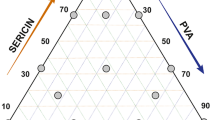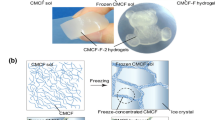Abstract
For hydrogel patches, the laboratory tests could not fully reveal the existing problems of full scale of industrial production, and there are few studies about the preparation technique for the industrial manufacturing process of hydrogel patches. So, the purpose of this work was to elucidate the effects of mainly technological operation and its parameters on the performance of hydrogel patches at the industrial-scale production. The results revealed the following: (1) the aqueous phase was obtained by polyvinylpyrrolidone (PVP) along with tartaric acid dissolved in purified water, then feeding this into a vacuum mixer as a whole in one batch, thus extended the crosslinking reaction time of hydrogel paste (matrix) and allowed the operation of coating/cutting-off to be carried out easily, and there was no permeation of backing layer; (2) the gel strength of the hydrogel patches increased with the increase of working temperature, however, once the temperature exceeded 35 ± 2 °C, the hydrogel paste would lose water severely and the resultant physical crosslinking structure which has lower gel/cohesive strength would easily bring gelatinization/residues during application; (3) the relative humidity (RH) of the standing-workshop was dynamically controlled (namely at 35 ± 2 °C, keeping the RH at 55 ± 5% for 4 days, then 65 ± 5% for 2 days), which would make patches with satisfactory characteristics such as better flexibility, higher adhesive force, smooth flat matrix surface, and without gelatinization/residues and warped edge during the using process; (4) the aging of the packaged hydrogel patches was very sensitive to storage temperature, higher temperature, higher gel strength and lower adhesiveness. The storage temperature of 10 ± 2 °C could effectively prevent matrix aging and adhesion losing, which would also facilitate the expiration date of patches extended obviously. In conclusion, this work provides an optimized and feasible preparation technique for the industrial production of the hydrogel patches and establishes the hydrogel patches as a novel carrier for transdermal drug delivery.











Similar content being viewed by others
References
Agrawal SS, Pruthi JK. Development and evaluation of matrix type transdermal patch of ethinylestradiol and medroxyprogesterone acetate for anti-implantation activity in female Wistar rats. Contraception. 2011;84:533–8.
Alexandera A, Dwivedi S, Ajazuddin, Girib TK, Saraf S, Saraf S, et al. Approaches for breaking the barriers of drug permeation through transdermal drug delivery. J Control Release. 2012;164:26–40.
Bao Y, Senos AM, Almeida M, Gauckler LJ. Rheological behaviour of aqueous suspensions of hydroxyapatite (HAP). J Mater Sci. 2002;13:639–43.
Brown MB, Martin GP, Jones SA, Akomeah FK. Dermal and transdermal drug delivery systems: current and future prospects. Drug Deliv. 2006;13:175–87.
Chen G, Hao BH, Ju DH, Liu MJ, Zhao HY, Du ZP, et al. Pharmacokinetic and pharmacodynamic study of triptolide-loaded liposome hydrogel patch under microneedles on rats with collagen-induced arthritis. Acta Pharm Sin B. 2015;5:569–76.
Dafader NC, Tahmina A, Haque ME, Swapna SP, Sadia I, Huq D. Effect of acrylic acid on the properties of polyvinylpyrrolidone hydrogel prepared by the application of gamma radiation. Afr J Biotechnol. 2012;11:13049–57.
Eva G, Stefan B, Stefan N, Werner W. Adhesion testing of transdermal matrix patches with a probe tack test—in vitro and in vivo evaluation. Eur J Pharm Biopharm. 2010;75:399–404.
Golla S, Neely BJ, Whitebay E, Madihally S Jr, Robinson RL, Gasem KAM. Virtual design of chemical penetration enhancers for transdermal drug delivery. Chem Biol Drug Des. 2012;79:478–87.
Gutschke E, Bracht S, Nagel S, Weitschies W. Adhesion testing of transdermal matrix patches with a probe tack test—in vitro and in vivo evaluation. Eur J Pharm Biopharm. 2010;75:399–404.
Hirobe S, Matsuo K, Quan YS, Kamiyama F, Morito H, Asada H, et al. Clinical study of transcutaneous vaccination using a hydrogel patch for tetanus and diphtheria. Vaccine. 2012;30:1847–54.
Ishii Y, Nakae T, Sakamoto F, Matsuo K, Quan YS, Kamiyama F, et al. A transcutaneous vaccination system using a hydrogel patch for viral and bacterial infection. J Control Release. 2008;131:113–20.
Jain P, Banga AK. Inhibition of crystallization in drug-in-adhesive-type transdermal patches. Int J Pharm. 2010;394:68–74.
Kandavilli S, Nair V, Panchagnula R. Polymers in transdermal drug delivery systems. Pharm Technol. 2002;26:62–80.
Kim KS, Simon L. Modeling and design of transdermal drug delivery patches containing an external heating device. Comput Chem Eng. 2011;35:1152–63.
Lai WF, He ZD. Design and fabrication of hydrogel-based nanoparticulate systems for in vivo drug delivery. J Control Release. 2016;243:269–82.
Lee TW, Kim JC, Hwang SJ. Hydrogel patches containing Triclosan for acne treatment. Eur J Pharm Biopharm. 2003;56:407–12.
Li WZ, Hao XL, Zhao N, Han WX, Zhai XF, Zhao Q, et al. Propylene glycol-embodying deformable liposomes as a novel drug delivery carrier for vaginal fibrauretine delivery applications. J Control Release. 2016;226:107–14.
Liu HG, Lee YI, Qin WP, Jang K, Kim S, Feng XS. Distinct composite structure and properties of Eu(phen)2Cl3(H2O)2 in poly(methyl methacrylate) and polyvinylpyrrolidone. J Appl Polym Sci. 2004;92:3524–30.
Matsuo K, Ishii Y, Quan YS, Kamiyama F, Mukai Y, Yoshioka Y, et al. Transcutaneous vaccination using a hydrogel patch induces effective immune responses to tetanus and diphtheria toxoid in hairless rat. J Control Release. 2011;149:15–20.
Mazzitelli S, Pagano C, Giusepponi D, Nastruzzi C, Perioli L. Hydrogel blends with adjustable properties as patches for transdermal delivery. Int J Pharm. 2013;454:47–57.
Mukherjee B, Mahapatra S, Gupta R, Patra B, Tiwari A, Arora P. A comparison between povidone-ethylcellulose and povidone-eudragit transdermal dexamethasone matrix patches based on in vitro skin permeation. Eur J Pharm Biopharm. 2005;59:475–83.
Okuyama H, Ikeda Y, Kasai S, Imamori K, Takayama K, Nagai T. Influence of non-ionic surfactants, pH and propylene glycol on percutaneous absorption of piroxicam from cataplasm. Int J Pharm. 1999;186:141–8.
Onuki Y, Hoshi M, Okabe H, Fujikawa M, Morishita M, Takayama K. Formulation optimization of photocrosslinked polyacrylic acid modified with 2-hydroxyethyl methacrylate hydrogel as an adhesive for a dermatological patch. J Control Release. 2005;108:331–40.
Onuki Y, Nishikawa M, Morishita M, Takayama K. Development of photocrosslinked polyacrylic acid hydrogel as an adhesive for dermatological patches: involvement of formulation factors in physical properties and pharmacological effects. Int J Pharm. 2008;349:47–52.
Peppas NA, Sahlin JJ. Hydrogels as mucoadhesive and bioadhesive materials: a review. Biomaterials. 1996;17:1553–61.
Peppas NA, Bures P, Leobandung W, Ichikawa H. Hydrogels in pharmaceutical formulations. Eur J Pharm Biopharm. 2000;50:27–46.
Prausnitz MR, Langer R. Transdermal drug delivery. Nat Biotechnol. 2008;26:1261–8.
Ren CS, Fang L, Ling L, Wang Q, Liu SH, Zhao LG, et al. Design and in vivo evaluation of an indapamide transdermal patch. Int J Pharm. 2009;370:129–35.
Schulz M, Fussnegger B, Bodmeier R. Influence of adsorbents in transdermal matrix patches on the release and the physical state of ethinyl estradiol and levonorgestrel. Eur J Pharm Biopharm. 2011;77:240–8.
Subedi RK, Oh SY, Chun MK, Choi HK. Recent advances in transdermal drug delivery. Arch Pharm Res. 2010;33:339–51.
Wokovich AM, Prodduturi S, Doub WH, Hussain AS, Buhse LF. Transdermal drug delivery system (TDDS) adhesion as a critical safety, efficacy and quality attribute. Eur J Pharm Biopharm. 2006;64:1–8.
Xing F, Tan Y, Yan GJ, Zhang JJ, Shi ZH, Tan SZ, et al. Effects of Chinese herbal cataplasm Xiaozhang Tie on cirrhotic ascites. J Ethnopharmacol. 2012;139:343–9.
Xu JC, Guo DW, Guo SR. Study on Viscomate NP-800 based hydrogel patch of indomethacin. Prog Mod Biomed. 2010;10:4356–60.
Acknowledgements
This research work was sponsored by the general programs of Shaanxi Science and Technology department (grant no. 2017JM8109 and 2017JM8023), the Provincial Key Discipline of Pharmacy of Xi’an Medical University (Grant no. 1007) and the Provincial Key Discipline Construction Project of Pharmacy of Xi’an Medical University (grant no. 2016YXXK01 and 2016YXXK07).
Author information
Authors and Affiliations
Corresponding author
Ethics declarations
Conflict of Interest
The authors declare that they have no conflicts of interest.
Human and Animal Rights and Informed Consent
The human studies obtained approval from the Ethical Committee of Xi’an Medical University.
Rights and permissions
About this article
Cite this article
Li, WZ., Han, WX., Hao, XL. et al. An Optimized and Feasible Preparation Technique for the Industrial Production of Hydrogel Patches. AAPS PharmSciTech 19, 1072–1083 (2018). https://doi.org/10.1208/s12249-017-0914-y
Received:
Accepted:
Published:
Issue Date:
DOI: https://doi.org/10.1208/s12249-017-0914-y




